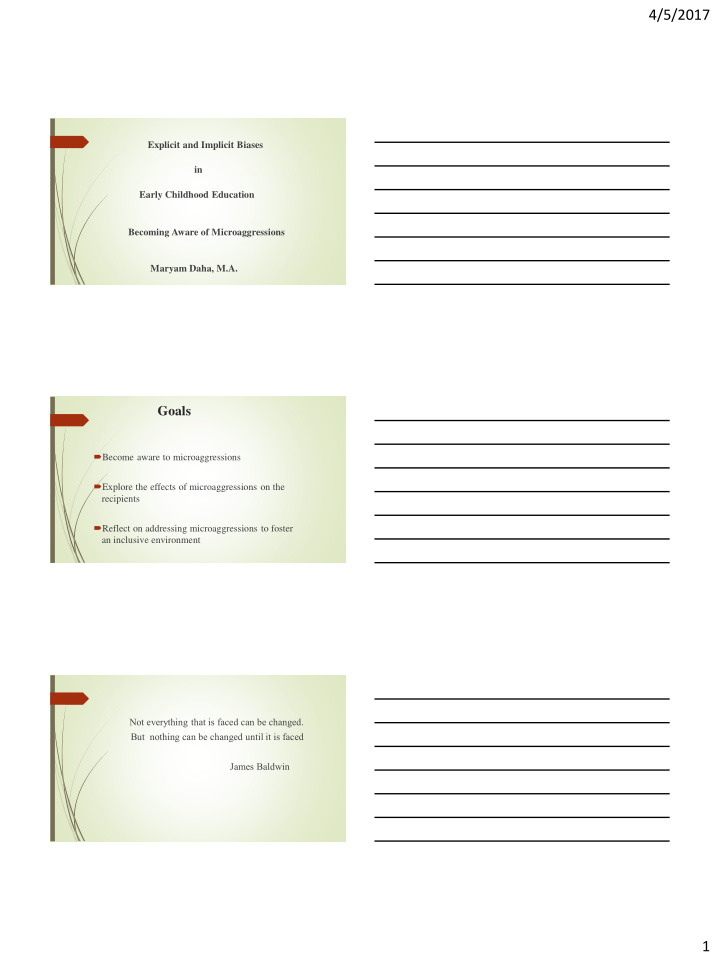



4/5/2017 Explicit and Implicit Biases in Early Childhood Education Becoming Aware of Microaggressions Maryam Daha, M.A. Goals Become aware to microaggressions Explore the effects of microaggressions on the recipients Reflect on addressing microaggressions to foster an inclusive environment Not everything that is faced can be changed. But nothing can be changed until it is faced James Baldwin 1
4/5/2017 Stereotypes Stereotypes are oversimplified generalizations about a particular group Have you heard of any stereotypes? Stereotypes Girls are not good at math Poor people are stupid Males who show their emotions are weak Stereotypes Role of the environment Sociocultural contexts 2
4/5/2017 Bias “ An attitude, belief, or feeling that results in, and helps to justify, unfair treatment of others” Stacey York Bias Overt Implicit A 5-year-old girl draws a picture for a class project. Her teacher says, “ Good job. You can share this with your mom tonight.” The girl pauses and responds, “I don’t have a mom.” 3
4/5/2017 Microaggressions Verbal comments Behavioral encounters Environmental slights Communicate negative messages and insults to individuals because of their group membership. Microaggressions Microaggressions can be carried out Consciously or unconsciously Intentionally or unintentionally. Microaggressions Carry messages of exclusion & invalidation to the recipients’ identities. 4
4/5/2017 Microaggression Coined by Chester Pierce in the 1970s. “ Microaggressions are brief and commonplace, daily verbal, behavioral, or environmental indignities, whether intentional or unintentional, that communicate hostile, derogatory, or negative racial slights and insults toward people of color.” Chester Pierce Microaggressions Microaggressions are prevalent in groups from all walks of life. People of color Women Lesbian, gay, bisexual, and transgender people (LGBTs) Persons with disabilities People from lower socioeconomic class Religious minorities disproportionately experience microaggressions in their everyday lives. 5
4/5/2017 Microaggressions Micro: Because the incidents can be small, hard to see. Aggression: Because their effects are like mental attacks or shocks to the recipient. Microaggressions Dearald Sue identifies three different types of microaggressions: 1. MICROASSAULT 2. MICROINSULT 3.MICROINVALIDATION Microassults Conscious Intentional Outward Verbal and Behavioral Actions. Name calling, using racial epithets, homophobic remarks, purposeful discrimination 6
4/5/2017 Microinsults Can be subtle Many times unintentional Happen due to biases and stereotypes that can be outside of one’s awareness Gender Microaggression A teacher calls out, “ I need the boys to show me their strong muscles and help me move these chairs and tables . ” Implying that only the boys are strong members of the class. 7
4/5/2017 Empathy is critical: Recognizing how our language and action affect others Sensing their feelings A teacher asks a father, who is from Kenya, if he can come to school and speak about his village. “The kids will love to hear about the lions and elephants.” Microaggressions How is the recipient impacted? 8
4/5/2017 The intentions might not mean any harm The impact is piercing and stinging Racial Microaggression s A director praises a Vietnamese American mother “ You speak perfect English.” What are the underlying messages? What are the interpretations? 9
4/5/2017 Intention does not equal impact Internal Dilemma Microaggressions are subtle The recipients feel the hurt but they may have conflicted feelings May question themselves: Am I interpreting the situation correctly? By the time they decide what to say it is too late This can bring in feelings of regret and resentment in them. 10
4/5/2017 Microinvalidations “You are reading too much into it.” “You are too sensitive.” “Stop playing the race card.” “It is all in your head.” “You are too emotional.” “I was just kidding.” Microinvalidations Verbal or Nonverbal Exchanges or Behaviors that Trivialize Exclude Ignore Dismiss Feelings and Thoughts of an Individual. Self Reflection is the key Regularly examining our assumptions, beliefs, and biases and the effects of these on the people in our lives. 11
4/5/2017 Responding to microaggressions depend on many factors including Context Who said it When it happened Environmental Microaggression Inaccurate and inappropriate portrayals of people based on their social identities Exclusion of books and images of people of diverse backgrounds in the classroom Native American mascots Impact of Microaggressions Studies show that cumulative effects of microaggressions can produce psychological distress affect physical health impact self-esteem influence academic performance (Allen, Scott, & Lewis, 2013; Kohli & Solórzano, 2012; Sue & Sue, 2012). 12
4/5/2017 Microaggressions can also cause a rift in family- teacher relationships (Daha, 2016) Listen Take a learning disposition Examples of Microaggressions Photo project at Fordham University I, too, Am Harvard 13
4/5/2017 The Implicit Association Tests The Implicit Association Tests (IATS) measure “one’s unconscious biases: thoughts and feelings outside of conscious awareness and control .” https://implicit.harvard.edu/implicit/takeatest.html Contact Information Share your stories and comments/questions with me dahamaryam@fhda.edu Maryam.daha@gmail.com References Allen, A., Scott, L.M., & Lewis. C.W. (2013). Racial micoraggressions and African American and Hispanic students in urban schools: A Call for Culturally Affirming Education. Interdisciplinary Journal of Teaching and Learning, 3 (2), 117-129. Daha, M. (2016). Recognizing and addressing microaggressions in teacher- family relationships. Exchange, 38 (2 ), 61-64. Kohli, R., & Solórzano, D. (2012). Teachers, Please learn our names! Racial microagressions and the K-12 classroom. Race, ethnicity and education, 15 , 441-462. Sue, D. W., & Sue, D. (2012). Counseling the culturally diverse: Theory and practice 6 th ed . New Jersey: John Wiley & Sons. 14
Recommend
More recommend